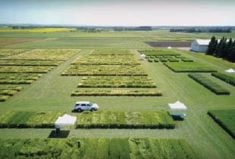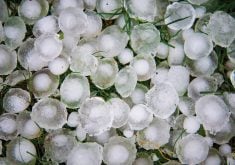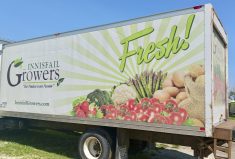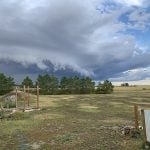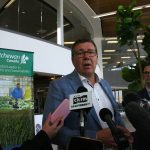The grass really is greener when it comes to landscaping crops — and the ornamentals smell pretty sweet, too.
“The market as a whole has been growing 10 per cent a year for the last 20 years, and the economic forecasts show that it’s only going to increase,” said Joel Beatson, executive director of Landscape Alberta.
“Gardening is still the No. 1 hobby in Canada, and as the baby boomers start to retire, there’s going to be a greater demand.”
With a farm gate value of around $123 million and more than 75 producers across the province, Alberta’s landscape agriculture sector is drawing traditional farmers who are looking to make a premium for their crops — on a lot less land.
Read Also

Solar and sheep provide valuable farm diversification
Agrivoltaics – the system of grazing sheep or conducting other agricultural activity under arrays of solar panels – can provide farmers with diversification options for their operations.
“We’re not commodity controlled the way a lot of other crops are, so growers can set their own prices, and the market thrives,” said Beatson.
But there are challenges. Each crop comes with a learning curve and many have a long growing cycle — between five to seven years for trees and up to three years for sod. And there’s no crop insurance.
“When you have weather issues, it can be even more devastating,” he said. “If it was one year away from harvest, you have four or five years of production time put into a product that you’re not going to be able to sell.”
And it’s no surprise labour is another challenge. The industry employs about 17,000 Albertans, making it second only to cattle as an ag employer.
“When you have to hand prune 10,000 trees, that can only be done by people,” noted Beatson.
But despite the challenges, business is booming. Here’s how two central Alberta farm families are making a go of growing landscaping crops.
Mountain Sod and Seed Farm
The number of sod operations in Alberta has more than doubled in the past five years, but the Mountain family got in on the ground floor.
“We’ve been in this business for over 50 years now,” said Peter Mountain, co-owner of Mountain Sod and Seed Farm near Innisfail. “My dad started it by growing Kentucky bluegrass seed and he harvested it for the seed purposes, not for the turf.”

In the mid-1960s, the Mountains were approached by a Calgary landscaping company wanting to cut some sod using a small walk-behind machine — a completely novel idea for the family’s patriarch.
“My dad said, ‘I’d have to see that to believe it,’” said Mountain. “Well, they brought their little walk-behind machine here and cut it one foot wide. That was the first sod that was harvested here.”
Today it’s a fully automated sod-stacking harvester, and the varieties have changed dramatically, too.
“The varieties we used in those days were more of a forage-quality seed,” said Mountain. “The newer ones are what they call dwarf and semi-dwarf varieties of Kentucky bluegrass. They grow shorter and get denser quicker, and they can tolerate a lot more mowing and a lot shorter mowing.”
The Mountains test new varieties to see how they perform in Alberta’s growing conditions and add ones they like to their own seed mixes.
“We don’t buy the seed premixed,” said Mountain. “We buy the straight strains, and we blend our own percentages of seed with our seed mixer so we physically see ourselves what’s going in the seed mix.”
Seeding takes place from early May to mid-August, and requires “a lot of preparation.”
“You want that field to be like a pool table. If you have a rough field, you get waste. You start throwing it away at $3 a roll, that hurts.”
A Pulvi-Mulcher, which has both packers and diggers, prepares the ground, which is seeded twice — straight one way and then at a slight angle “to break the pattern up.” They use about 50 pounds of seed per acre.
“If you get really good seed — the best there is — maybe 80 per cent germinates,” said Mountain.
That drops when seed is stored, so the goal is to get new seed annually.
As a perennial plant, the grass will regrow, but the Mountains don’t use the regrowth in their harvest “unless (they) absolutely have to.”
“We used to do it quite a bit, but now we’re running on the field with the big trucks and the tractors harvesting when it’s wet,” he said. “To try to get a good cut off of there next time, your quality is down. We make a point to work it up and reseed.”
Sod takes up to two years to mature and the Mountains rotate with wheat or barley — meaning they only get three sod crops off a decade on their 200 acres.
“It’s the same with any other crop. You can’t keep cropping continually and expect it to produce properly.”
And they face a different type of race at harvest — sod should be installed within 24 hours of being cut.
“I’ve heard of guys having it spoil on the truck between here and Grande Prairie,” said Mountain.
So they market mainly to central Alberta, and most of their business comes from word of mouth.
“If you sell a customer a good product and he’s happy, he’ll tell a couple of people. If you sell a customer some poor-quality product, he’ll tell everybody,” said Mountain.
“My dad always said, ‘If you’ve got a good-quality product — no matter what it is — you will sell some. If you’ve got a poor-quality product, you’ve got to give it away.’ And we’re not in the business of giving turf away.”
Gable House Farm and Gardens
Carolyn and Jeff Bondy never set out to become daylily producers when they retired to Carolyn’s family farm near Sylvan Lake.
“It kind of came serendipitously to us,” said Carolyn. “We wanted to buy a cargo trailer, and we ended up buying the (seller’s) daylily business too.”
The couple started with 70 varieties of daylilies and a steep learning curve. Five years later, they grow more than 450 varieties, with customers across Canada.
“We’ve fallen in love with them,” said Carolyn. “It’s a wonderful crop to grow. You wouldn’t necessarily think of it as a crop, but it is.”
Over the years, the Bondys have had to learn which cultivars will work in Alberta’s climate.
“What we have here, we’ve tested before we approve them for sale and determine whether they’ll be worthwhile keeping,” said Jeff.
“There’s a lot of plant material that comes out that’s tested for Zone 4, but we don’t live in Zone 4,” Carolyn added. “I’m really happy to test the daylilies for our zone (Zone 2).”
The Bondys only grow registered varieties.
“Registered daylilies are like registered animals,” said Carolyn. “They’ve gone through a process and there’s a family history you can trace as to what’s in their lineage.
“We don’t just sell daylilies that have been cooked up in somebody’s backyard.”
New cultivars from across the country are trialled in their small test plots.
“First of all, we want to see if they’re going to winter,” said Carolyn, adding that no mulch is used for insulation during the testing phase.
“The next thing we want to see is what kind of pretty face we’re going to have and what kind of foliage we’re going to see. Is it going to have nice, clean foliage that doesn’t brown by midsummer?”
The couple also wants to see how quickly the plants will multiply.
“They don’t run — they multiply from the middle outward — but some of them are slow, and some of them are quick.”
But one thing the different cultivars have in common is their surprising hardiness.
“Our garden suffered from drought to begin with,” said Jeff. “It was so dry here, and we got rice-like hail early in the season. We also had two killing frosts. But the plants did quite nicely in spite of all that.”
They also ship well, said Carolyn. When ready for harvest — any time between spring and late summer — clumps are divided into two or three separate plants, cleaned, trimmed of all leaves, and put in the mail. Even after two weeks in transit, they’re usually good to go.
“After that period of time, you have to soak them and then plant them and keep them hydrated for about two weeks,” said Carolyn.
Most sales come from the Internet or word of mouth, and the couple doesn’t sell south of the border because that requires “phytosanitary certificates.”
Annual sales have hit $10,000 and the daylilies are multiplying so fast that supply is outstripping demand. But the Bondys are at the limit of what they can handle.
“Jeff and I can’t manage any more on our own with just the two of us,” said Carolyn.



